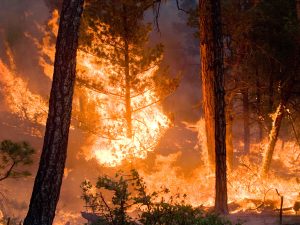By KAY MATTHEWS
The United States Forest Service, The Nature Conservancy, Forest Guild, and Wildearth Guardians (that was a surprise) all got together a week or so ago to talk about “Living with Fire in Northern New Mexico.”
Craig Allen and Tom Swetnam, the scientists who’ve done extensive research in New Mexico forests were there to discuss climate change and fire impacts; Eytan Krasilovsky of Forest Guild and the project director of the Rio Trampas Forest Restoration Project talked about fire adapted communities and forest resilience; and Forest Service personnel laid out the agency’s fire fighting management policies.
In my October article “Wildfire Management: the “Hands On, Hands Off” Debate I questioned the consistency of Forest Service fire fighting management; at the meeting the Forest Service said its policy is defined by three categories: full suppression; allowed to burn; and prescribed fire. All human caused fires fall under the full suppression mandate. Lightning caused fires that are “in the wrong place at the wrong time,” meaning during conditions of high temperature, low humidity, and dry conditions or located in watersheds or near communities also fall under the full suppression parameters.
Those fires “allowed to burn” must meet multiple objectives, i.e., ground fire of low intensity to help thin overgrown forests in isolated areas outside of the wildland urban interface. If the fires meet these criteria the Forest Service has the time to consult with other agencies such as the Air Quality Bureau to monitor and assess the fire’s progress.
Prescribed fires fall under the guidelines of the National Environmental Policy Act (NEPA) and follow the Prescribed Fire Burn Policy.
The Forest Service gave examples of fires within the categories: the massive Las Conchas and Tres Lagunas fires in the Jemez and Sangre de Cristos were full suppression fires that threatened Los Alamos National Laboratory, the Santa Clara Pueblo watershed, and the Pecos watershed.The 2010 Ojito Fire outside of Chamisal burned approximately 300 acres and met allowed burn objectives.

There is another category that didn’t come up in the meeting until I asked about the Jaroso Fire that burned in the Pecos Wilderness last summer. The fire would have fallen into the full suppression category as it was burning in hot, dry conditions, with enormous fuels from a previous blow down, and threatened several watersheds on the west and north side of the wilderness, but it became the third category of too “dangerous” to fight. The other factor that caused this re-categorization is that the fire was far enough away from the wildland urban interface to not pose any immediate threats to people and houses and allowed the Forest Service to back away. The “too dangerous to fight” category seems likely to become the agency’s default position as so many fires become essentially uncontrollable conflagrations because of drought conditions and climate change. The tragic outcome of sending fire crews to these kinds of fires resulted in the deaths of the 19 firefighters in Arizona last summer.

The distance between the wildland urban interface and wilderness is shrinking; public lands managers and state governments are being hard pressed to protect communities that are contingent to or built within forested lands. Colorado recently proposed “that lawmakers charge fees on homes built in woods, rate the wildfire risk of the 556,000 houses already built in burn zones on a 1-10 scale and inform insurers, and establish a state building code for use of fire-resistant materials and defensible space.” In Colorado approximately one of every four houses is built in wildfire zones. While the state isn’t going so far as to enact laws that restrict development in these zones, the proposed regulations at least provide financial disincentives to build there.
The biggest surprise at the meeting, at least for me, was the announcement of The Nature Conservancy’s (TNC) Rio Grande Basin Water Fund, a 10 to 30 year project to leverage funding for forest restoration in the upper Rio Grande Basin. Largely in response to the 2011 Las Conchas Fire that caused both Albuquerque and Santa Fe to shut down their San Juan/Chama water supplies for 40 and 20 days respectively (to prevent ash from clogging their diversion dams), the Fund aims to increase water security in this most critical water basin. TNC wants to treat 700,000 acres of overgrown forests “including 40 percent of the most high-risk areas in the Rio Grande watershed”: thinning overgrown forests, restoring streams, and rehabilitating areas that flood after wildfires.
After a year of scoping, TNC hopes to have a fund established by spring or early summer of 2014. In an initial study funded by Bernalillo County, and in collaboration with the United States Geologic Survey (USGS), TNC has been studying the Sandia and Manzano Mountains to assess the “probability of burn” and the “probability of burn debris flow” to help identify where work on the ground needs to focus. The Jemez Mountains will be next on the study list, and then the west slope of the Sangre de Cristos.
TNC hopes to leverage money from a “flexible” funding source that can include both public land agencies, state and local governments, and private businesses that realize how vulnerable our communities and economies are to catastrophic fires in the watershed. As TNC’s Laura McCarthy puts it, “People care a lot about forests but they care about water more.” Flexible funding can be directed to groups like Forest Guild, whose NEPA work on the Rio Trampas Forest Restoration Project will have 10,000 acres ready for treatment.
The New Mexico legislature took a first step last session to identify the state’s most critical watersheds after seeing the damaging effects of the Las Conchas Fire. House memorials and joint memorials were argued over, amended, and passed that called for the state agencies, along with tribal and federal agencies to develop and implement proactive best management practices to both prevent and minimize fire impacts on watersheds such as the San Juan/Chama and the Gallinas above Las Vegas. TNC hopes to work collaboratively with the legislation to leverage state funding in the next 60-day session. As Craig Allen said in his presentation at the meeting, we have a short window of opportunity to make our forests more resilient as we head into many years of drought and climate change conditions. Time is of the essence.

Thank you Kay Mathews, for this article for the health of Mother Nature.
I wonder about …who has benefitted in the recent past, and who benefits in the implementation of
the “thinning overgrown forests”, ” and the colorado proposal “that lawmakers charge fees on homes built in woods….””
Is there also talk of a program to insure that those who may need wood the most as it is their primary heat source, are low income, are with children, without trucks, be able to have access to the thinning?
Can thinning be transplanted to areas that need re-forestation and areas that need more trees?
Would “fees” such as these become a financial hardship on some people?
You make some important points. Here in New Mexico many of the small, commercial loggers went out of business because of lack of access to forest products brought about by poor USFS management and enviro lawsuits. Land grant communities in el norte have long complained about having to get permits to cut firewood when they’re essentially thinning the woods for the USFS. The contract stewardship program, which has proved to be a big success, can’t keep up with the demand.
As for fire danger, most of our forest communities have been here for hundreds of years and are largely protected by agricultural fields and the more traditional building material of adobe (although obviously there are more and more mobile homes). Many of the most vulnerable communities are those built within the woods adjacent to small villages or towns by second home and vacations home owners, or built by developers as more suburban type communities. I would hope that in Colorado, and in New Mexico if it ever follows suit with more restricted building regulations, that financial help would be provided to rural ranchers and farmers if they need it.
The more that things change, the more they stay the same.
I had to laugh out loud over the statement that Las Conchas was a full suppression effort. If you believe this, then you are certainly prepped and ready to digest the full banquet of Forest Service politispeak. First and foremost in this deranged religion of fire worship, is the fervent tenet that the actions of a compromised, politically caricatured agency, and its acolytes are somehow going to save the forest. Second, is the odd assurance that humans have the slightest understanding of what they’re doing in the forest, with their lopsided attempts to “manage” it. Third is the credit that anything that is done in the forest, is actually for the forest, rather than for some economic, ideological, or political master, which by the way, is really the case.
A great example of this is the current fire cult, that wild eyed foaming at the mouth obeisance toward human induced fire as the true magic wand of forest “restoration”.
Ah yes, “restoration”, that intentionally misapplied word, sort of like the “patriot” act.
Today “restoration” means full scale logging by well connected corporations who get to profit as long as they have nothing to do with local communities. “Restoration” means burning even more tortured acres of thoroughly defiled land, to the point that water sheds get buried under sedimentation, that severe downcutting removes thousands of years of precious topsoil, to the point that the towering geniuses in uniform now think of trees as “weeds”.
Yes, we can expect great things with the fire cult, and the morons in uniform who can’t tell a tree from a weed, but hey, that’s where all those fat grants come from, isn’t it? All that money, piles of it, to buy new suits for urban enivros, and new atvs for psychopaths in uniform.
Here is the truth, that which no one wants to hear. The forest does not have a static point at which it is perfect, it is an expression of the will of LIFE, and as such is dynamic and very much alive. No one needs more brain dead cultists burning anything, except for once, their own houses. Time does not work on a human schedule. Unless fully restricted and contained, off road vehicles, and the fossil fuel junkies who ride them, are a clear and present danger to the thriving forest.
Until those who claim to defend the forest understand the forest as a living entity that responds, grows, and dies in complex and interrelated ways, they will only inflict more harm with their well funded good intentions.